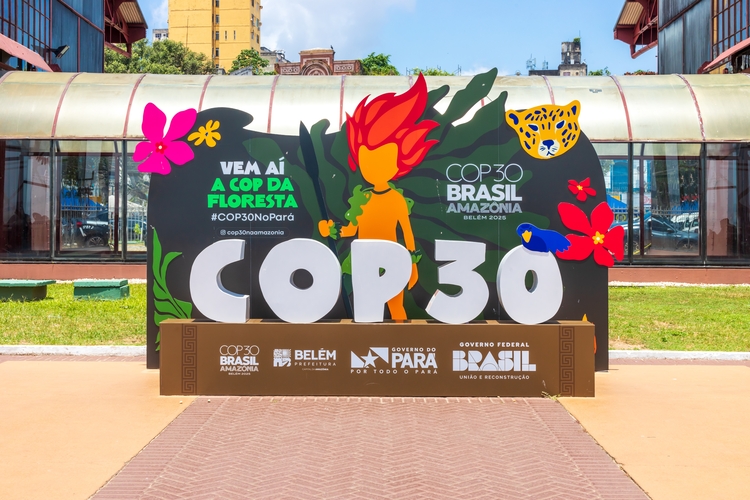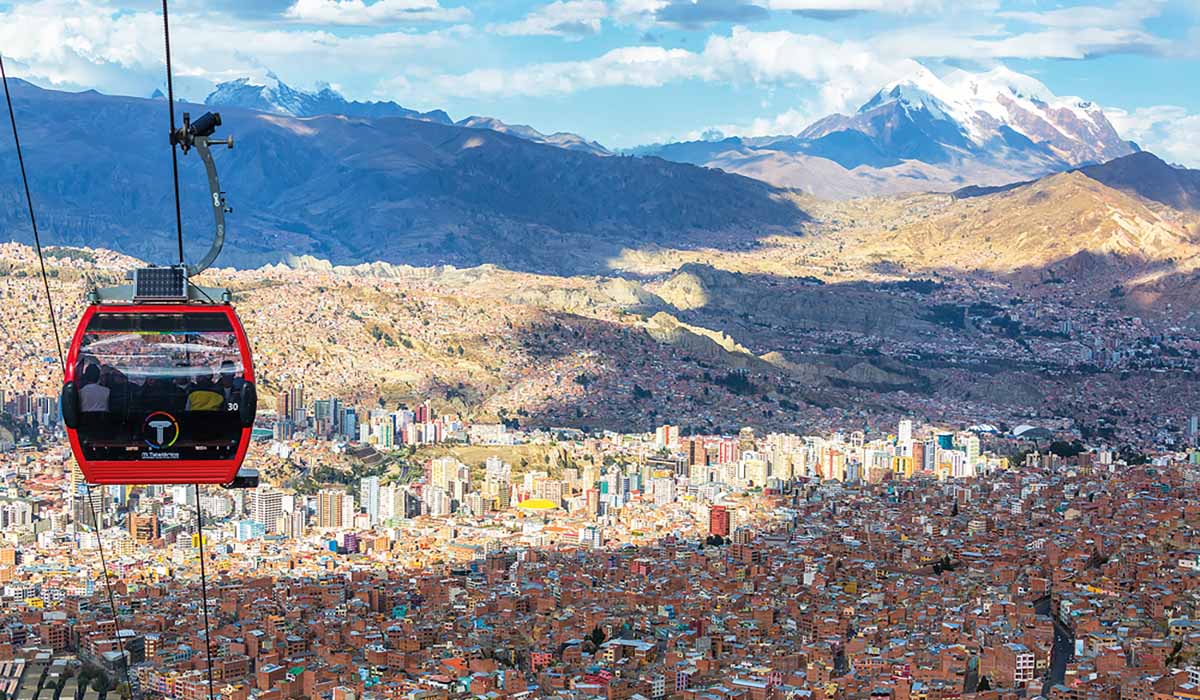
Situated above La Paz, El Alto is Bolivia’s youngest and highest city, a place where the past and the future collide
By Shafik Meghji
A decade on from my first visit to La Paz in 2004, my early-morning flight touched down at El Alto’s airport, 4,061.5 metres above sea level. The lethargic immigration officials seemed a little surprised by the sudden appearance of a dozen foreign travellers. They conferred briefly before waving us through to the deserted arrivals hall. The cafés and souvenir shops were closed and the only sounds were plaintive yelps from a dog carrier that circled slowly on a luggage carousel. Outside the terminal, a pair of taxi drivers leaned idly on their cars, barely summoning the energy to conjure up an inflated fare for the arriving gringos.
This low-key arrival was scant preparation for the views that soon materialised before me. Few cities have as dramatic a location as La Paz, which is draped across a canyon high in the Andes. I stared down at a carpet of terracotta-coloured, Lego-block-style homes clinging precariously to the near-vertical slopes. Tower blocks poked out of the city centre like flowers stretching for the sun and the triple-peaked, snow-topped Illimani, the second-highest mountain in Bolivia, loomed prominently in the background beneath an unblemished sky.
But, as my taxi wound its way down into the canyon, the altitude – roughly 3,650 metres in the city centre – began to take its toll. La Paz is one of the world’s highest cities and arriving here from lower elevations feels like ageing prematurely. A powerful invisible force, it made climbing the short flight of steps up to my guesthouse seem comparable to scaling Mount Everest. As I sat on the bed in my room, I became increasingly aware of the pressure on my lungs and struggled to catch my breath. Nausea dulled my appetite but I had an unquenchable thirst. Sleep that night and the next proved elusive. Instead, vivid, unsettling waking dreams occupied my mind as I lay shivering beneath the woollen blankets.
To aid the acclimatisation process, locals advise first-time visitors to the city to ‘eat little, drink little and sleep alone’. The most expensive hotels go so far as to provide guests with oxygen tanks; my guesthouse offered a pot of coca-leaf tea and a bowl of boiled coca sweets. The former tasted like blitzed-up lawn clippings, the latter like grassy cough drops. Over the next few days, my symptoms gradually eased but they never entirely disappeared. A strange sensation persisted throughout my stay in La Paz – as if I wasn’t quite there.
The Moon and the Earth
I’d returned to the city to see how it was coping with some of the thorniest issues of the early 21st century: mass migration, urbanisation and shifting identities. Bolivia is currently undergoing rapid change. According to statistics from the World Bank, between 2006 and 2011, some 2.6 million Bolivians – roughly a quarter of the country’s population – migrated to cities, and the rate has since increased. Around 70 per cent of Bolivians now live in urban areas, compared to 55 per cent in 1990. Hundreds of thousands of these internal migrants have flocked to the plateau above La Paz, interrupting the near isolation of a city that had sat alone in its canyon, surrounded by the inhospitable altiplano, for some 400 years.
La Ciudad de Nuestra Señora de la Paz (The City of Our Lady of Peace), to give the city its full title, was founded in 1548. A major seat of Spanish colonial power in the Andes, it prospered as a stopping place on the valuable trade routes between Buenos Aires and Lima, and the silver mines of the altiplano and the Pacific coast. Today, La Paz is regularly described as the world’s highest capital city but this isn’t quite right – although it is the country’s political hub, Sucre, 700 kilometres to the southeast, is the official capital. The majority of La Paz’s roughly 955,000 residents have indigenous Aymara heritage. Their language is one of the few in South America to have survived the arrival of both the Quechua-speaking Incas and the Spanish-speaking conquistadors.
La Paz, wrote Pico Iyer in The Man Within My Head, is ‘an ironist’s delight with its defiance of all reason’. Here, the poor look down on the rich. Literally. Working-class districts range across the canyon’s precipitous slopes in tightly knit clusters of brick-and-corrugated-iron homes in varying stages of completion. Below are the middle classes in slightly smarter houses, and the neighbourhoods grow more prosperous still the further you descend.
Despite progress between 2006 and 2019 under the Morales government, Bolivia remains profoundly unequal, with class, ethnic and racial structures that, in some respects, have changed depressingly little since the colonial period. The city’s wealthiest residents congregate at the base of the canyon in the Zona Sur neighbourhood, overlooked on all sides, their escape routes blocked by regular strikes and protests.
Stay connected with the Geographical newsletter!
In these turbulent times, we’re committed to telling expansive stories from across the globe, highlighting the everyday lives of normal but extraordinary people. Stay informed and engaged with Geographical.
Get Geographical’s latest news delivered straight to your inbox every Friday!
Outsiders often unfairly depict La Paz as being stuck in some kind of vacuum, distant from the wider world, globalisation and modernity. But spend a bit of time here and you’ll quickly realise that the future has firmly arrived. During the early 20th century, railway lines were built across the altiplano to link La Paz with Titicaca to the west and Chile’s Pacific ports to the southwest. These were followed by an airstrip and an air force base. A fledgling settlement named El Alto (The Heights) developed on the canyon rim above the city to service these new transport links. It remained little more than a village until the 1952 National Revolution.
One of the key moments in Bolivian history, the revolution led to universal suffrage, land reforms that freed many workers from near-feudal conditions, nationalisation of the valuable tin mines and increased industrialisation. Coupled with a major drought, these changes prompted great population movements and thousands of people, the vast majority of whom were indigenous, travelled across the altiplano to La Paz in search of work. Few could afford to live in the city itself, so instead settled in El Alto, whose population grew steadily, reaching 30,000 in the mid-1960s.
‘The next wave of migration was linked to the construction boom of Hugo Banzer’s dictatorial regime in the 1970s, fuelled by foreign debt and US aid,’ wrote Sian Lazar in El Alto, Rebel City. By the mid-1970s, El Alto’s population had topped 100,000. Migration rates to the conurbation accelerated in the next decade as the country plunged into a deep depression and extreme droughts decimated agricultural communities.
Throughout this period, the Bolivian government tended to view El Alto as little more than a satellite of La Paz, a loose collection of crime- and poverty-ridden ‘shanty towns’. Some even described it as merely an ‘appendix’. There was scant investment in infrastructure and city status was granted only reluctantly. Nevertheless, El Alto’s population continued to grow vigorously, hitting 650,000 by the turn of the millennium, thanks in part to the impact of the climate crisis on already struggling rural communities. Along the way, it developed a distinct Aymara identity and political consciousness, the influence of which has since rippled out across the country. Today, El Alto is the second-biggest city in Bolivia, with around a million residents – roughly 150,000 more than La Paz. The Moon has outgrown the Earth.

Impossible to ignore
On a sunny autumnal morning a few days after arriving in La Paz, my head still fuzzy from the altitude, I waited in Plaza San Pedro for Alejandra, a brisk, efficient university student in her early 20s who was dividing her time between writing a thesis on sustainable tourism and guiding travellers around the region’s less heralded attractions – in particular El Alto.
You might also like
A trufi (fixed-route taxi) arrived for our journey up to El Alto, a place that some in La Paz view with little affection. As we crawled up a precipitous hill, I spotted a figure dressed in a zebra outfit gently supporting the arm of an elderly woman as she crossed the street. Further on, another zebra danced a jig, waving enthusiastically for the traffic to stop and gesturing flamboyantly to waiting pedestrians. ‘The city authorities get young people in zebra costumes to promote traffic safety and help people cross busy roads,’ Alejandra explained. ‘Others wear donkey costumes and hug you if you cross at the wrong time. People respect the zebras more than the police. A few weeks ago, an angry driver pushed over a zebra and was beaten up by some passers-by. We love our zebras.’
The trufi continued to wheeze uphill until we reached a forest of telecommunications towers that mark the edge of the pancake-flat expanse of El Alto. ‘Welcome to the Aymara capital of the world,’ said Alejandra as we disembarked. The streets were lined with mismatched bare-brick homes, their roofs sprouting knots of cables, antennae, satellite dishes and metal rods for additional storeys, a symbol of optimism for the future. Several were linked by strings of colourful flags, the remnants of a recent fiesta. There were building sites everywhere I looked and the air thrummed with the sound of drills and saws. Alejandra guided me to a small market whose stalls were laden with fruit and vegetables, leathery strips of dried llama meat, mutton carcasses and feathery chickens in cages. Vendors sold tasty deep-fried doughnut-like buñuelos doused in syrup, overflowing glasses of rose-red cinnamon sorbet and papas rellenas – stuffed balls of mashed potato served in greaseproof paper with an array of salsas. Nearby, a group of men sat on plastic stools, slurping bowls of nourishing soup filled with tiny silverfish. Behind them stood an abandoned tower with a satellite dish at the top and a half-built revolving restaurant.
‘El Alto is the youngest city in Bolivia. It is only around 35 years old, and the highest in the world at 4,150 metres, even higher than Potosí,’ said Alejandra as we nibbled chunks of quinoa chocolate and slices of sweet, brilliantly pink cactus fruit. ‘Hundreds of thousands of people migrated to find better opportunities in La Paz, stopped off here as it was cheaper, and built their own homes. There was nothing really in El Alto, just the airport. Now there are over a million people here, more than in La Paz. Only Santa Cruz in the east is bigger. There are probably more people here – nobody trusts the census. Most people speak Aymara and identify themselves as such, although really in Bolivia we’re all mestizos [mixed race].’
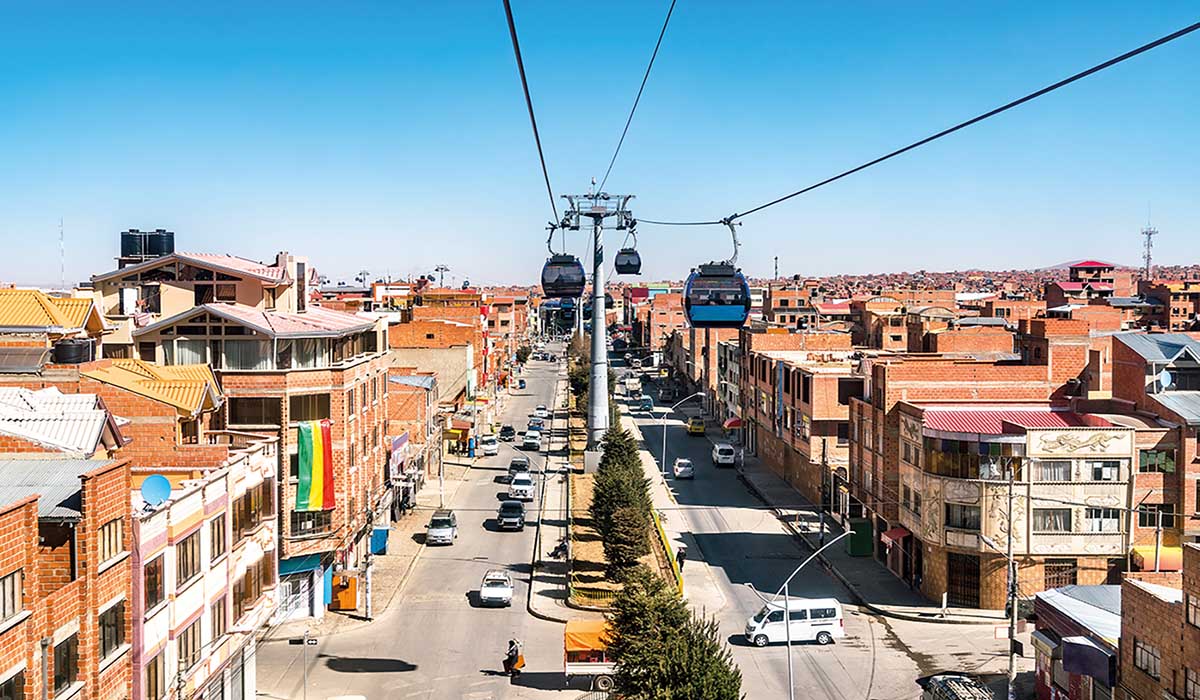
She explained that many of the migrants came from altiplano mining towns, whose long decline accelerated in the 1980s thanks to the collapsing price of tin, hyperinflation and a looming economic crisis. Others came from rural communities badly affected by drought, floods, mudslides, crop failures and sometimes all of these combined. Despite their shared heritage and the fact that tens of thousands of alteños commute to La Paz every day for work, with similar numbers of paceños passing through El Alto, the two cities exist uneasily alongside each other. When I mentioned El Alto to the receptionist at my guesthouse in La Paz she shook her head vigorously: ‘Why would you go there? It’s dangerous. Many, many thieves.’
This appeared a common belief, although not one necessarily rooted in reality. The only reason most paceños spend time in El Alto is to catch a flight or shop at the sprawling Feria 16 de Julio, one of the largest markets in South America, where everything from food, clothes and household goods to electronics, cars and farming equipment are for sale (alongside a fair share of illicit items). Stung by paceño denigration, many alteños, in turn, dismiss La Paz as la hoyada (‘the hole’). A famous billboard stands above one of the city’s busiest intersections: ‘El Alto is not part of Bolivia’s problem. It is part of Bolivia’s solution.’
‘There are still racist views of El Alto: that it is dirty, chaotic, a shanty town,’ said Alejandra. ‘People still have this idea, especially in the Zona Sur, among so-called “high society”. Because of the 16 de Julio market, paceños come here now. But they won’t eat anything, still say it’s dangerous and wouldn’t dare come at night. They’d rather pretend it wasn’t there.’
But as it expands upwards and outwards at great pace, El Alto is impossible to ignore. After decades of neglecting the city, the government belatedly decided to act. In 2014, shortly after my visit with Alejandra, the world’s highest and longest urban cable-car system opened, linking El Alto and La Paz. The US$234-million Mi Teleférico (My Cable Car) echoed a scheme in the Colombian city of Medellín that connects deprived outlying neighbourhoods with the city centre and is credited with reducing crime and promoting social inclusion. It’s dramatically quicker than travelling via the cities’ painfully congested roads: many commutes that take an hour or more by bus or trufi are reduced to around ten minutes on Mi Teleférico, whose ten lines are used by hundreds of thousands of people every day, even though fares are a little higher than other forms of public transport.
The project also had huge symbolic value. For Morales, it was seen as a demonstration of his left-wing government’s adroit handling of the economy, which grew, and also showcased the country’s innovation and technological prowess. As with Bolivia’s telecommunications satellite – launched in 2013 to expand access to internet and mobile phone services to millions of people, and celebrated on countless billboards across the country during my visit – Mi Teleférico was an elegant rebuttal to outsiders who’ve attempted to paint the country as backward, poverty stricken and trapped by the past. The project was perhaps even more significant for the residents of El Alto. It recognised the city’s permanence and economic importance, and challenged a process of othering that has painted alteños as somehow fundamentally different from their paceño neighbours.
Political city
El Alto has always been a vibrant political force. In 2003, a year after narrowly edging out Morales in the presidential elections, the neoliberal Gonzalo Sánchez de Lozada (commonly known as ‘Goni’) was forced to resign and flee Bolivia after mass demonstrations broke out over the fate of the country’s vast natural gas reserves. The politically engaged residents of El Alto played a key role in the ‘Gas War’, their protests essentially cutting off La Paz from the rest of Bolivia and laying the groundwork for the rise of Morales to the presidency following the 2005 elections. ‘Ever since, politicians have been scared of El Alto,’ said Alejandra.
These protests echoed an indigenous uprising against Spanish colonial rule, led by Aymara revolutionary Túpac Katari (Brilliant Serpent) and his wife Bartolina Sisa, two centuries earlier. From the edge of the canyon rim, an area now occupied by El Alto, their 40,000-strong army laid siege to La Paz for 184 days in 1781. Finally, Sisa and then Katari were captured, killed and dismembered. Katari’s last words were reputedly: ‘I die as one, but will return as millions.’ In some respects, he was right. The story of Katari and Sisa continues to inspire radical indigenous (and particularly Aymara-based) movements, while blockading La Paz remains a popular form of political protest. Moreover, El Alto’s population is predicted to top 2.5 million by 2050.
Today, the city remains a cauldron of political activism. It was a stronghold for Morales, who oversaw significant economic growth and poverty reduction during his time in office, and the site of significant upheaval in the wake of the disputed 2019 election, after which he was temporarily forced into exile. But despite its links with the former president’s nominally socialist political movement, the city is also a thriving hub of capitalism. Alongside the Feria 16 de Julio and myriad other activities that straddle or flagrantly cross the line of legality, there are thousands of factories, warehouses and workshops. By some measures, El Alto is now the second-largest manufacturing and industrial centre in Bolivia. Poverty and unemployment rates are high but widespread participation in the informal economy mean they don’t tell the whole story. ‘El Alto is simultaneously the most revolutionary city, perhaps in all of Latin America, at the same time as it’s the most neoliberal city, the most individualistic city in all of Latin America,’ Professor Benjamin H Kohl of Temple University, Philadelphia, told the New York Times.
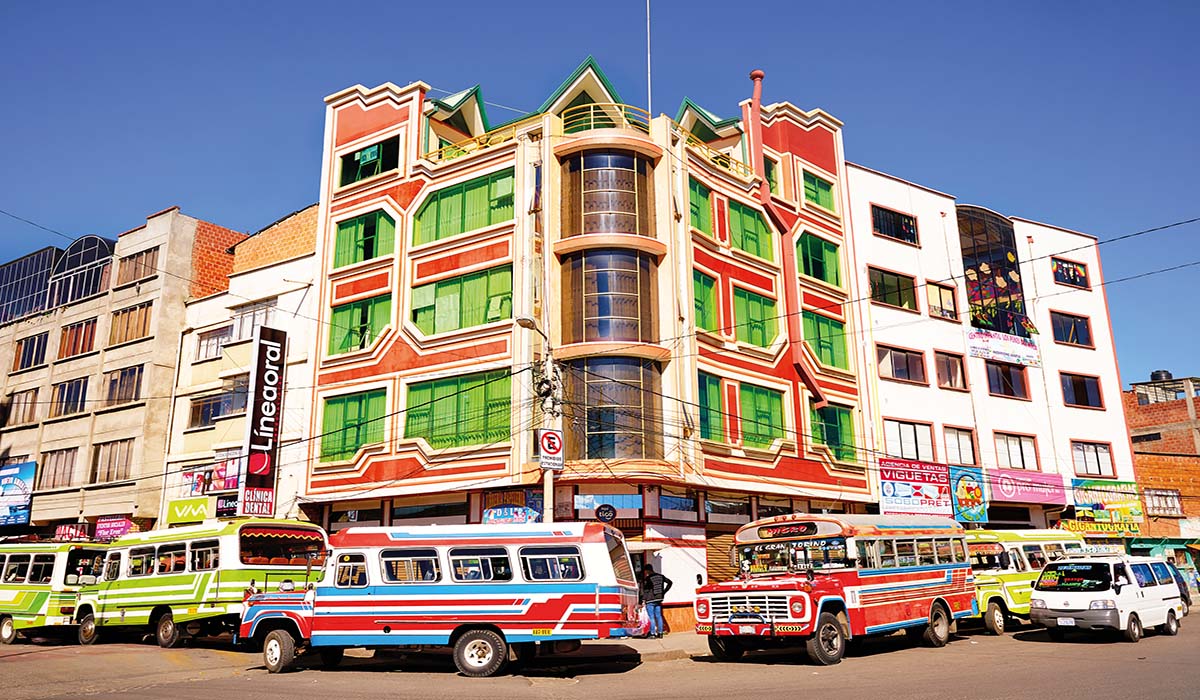
Cholet life
Viewed from on high (I took in the view from the Museo de Artes Antonio Paredes Candia), one of El Alto’s most distinctive sites are its cholets. A compound of the words cholo, a pejorative term used by the Spanish to refer to indigenous Bolivians, and chalet, these buildings represent a new and inventive form of architecture that is distinctly Aymara and alteño. They emerged in the early 2000s, the brainchild of former bricklayer Freddy Mamani Silvestre, who later became an engineer and architect and has since been compared to Gaudí, Oscar Niemeyer and even Michelangelo. He has created dozens of flamboyant, vividly coloured, layer-cake cholets that blend traditional and modern elements, and have spawned countless imitators.
In 2017, I returned for a closer look at the cholets with another local guide, Jorge. We met at my guesthouse in downtown La Paz before taking the teleferico up to El Alto, soaring over densely packed working-class neighbourhoods. In the distance was the Estadio Hernando Siles, one of the highest football stadiums on Earth; the Bolivian national team has a predictably formidable home record and had beaten Argentina a few months earlier. We got off at El Alto’s Ciudad Satélite teleferico station, which was modern, efficient and scrupulously clean. Students took advantage of the free wifi, and stray dogs, adopted by the staff and kitted out with warm coats, lay contentedly in the main hall. We caught a taxi to the Santiago I district, which is known for its expensive cholets, and were dropped off at an elaborate red, blue and grey cholet designed to resemble the Transformers character Optimus Prime; another of the architect’s creations is based on the Marvel superhero Iron Man. These buildings, Jorge explained, allow wealthy Aymara residents to assert their status and heritage: we have money, we are proud of our identity and we – and El Alto – are here to stay, they appear to say. ‘There have always been rich Aymara, but before Evo [Morales], they were timid. They didn’t want to draw attention to themselves,’ said Silvestre in one interview. ‘Now they say: “This is where the successful Aymara live”.’
Beyond their symbolic value, the buildings are profitable businesses; Jorge described them as ‘tools’ for their owners. Most of the cholets have a similar layout: the ground floor has stores or a shopping arcade; the floors above host event spaces to be hired out for the lavish religious celebrations, weddings and birthdays that form a key aspect of Aymara culture; further up there are apartments for rent; and at the very top of the building is a ‘chalet’, typically a duplex home for the cholet’s owner and their family. The fanciest cholets boast swimming pools or indoor five-a-side football pitches, while towers, spires and even Russian-style onion-domes are used to decorate the roofs.
Jorge showed me around a five-storey cholet owned by one of his contacts. The kaleidoscopic exterior combined peach, burnt-orange, maroon, lime-green and chrome decorations to dazzling effect. More mundanely, the shops on the ground floor sold mobile phone accessories, party costumes and DIY goods. Inside the entrance, the hallway was functional, even austere, with plenty of bare concrete and every scrap of space utilised for storage, mainly of empty beer crates. By contrast, the cavernous party halls on the second and third floors were a riot of colour and ornamentation. The high ceilings had galaxies of tiny white lights and huge multi-tiered chandeliers. There were long marble bars, curvaceous balconies and pastel-shaded pillars, as well as flashing panels and cloud-shaped mirrors. The walls were decorated with murals and reliefs of traditional Andean symbols and Tiwanaku iconography: condors, chakanas – which have four equal-length stepped sides and are also known as ‘Inca’ or ‘Andean’ crosses – pyramids, agricultural terraces and the Sun, Moon and stars. The room felt like a technicolour dream or a fairground ride – gaudy but glorious.
This cholet could cater for 600 people but some have the capacity for 1,000 or more. Parties can last several days and feature live music, copious amounts of food and booze, and outfits that cost hundreds or even thousands of dollars, Jorge continued: ‘In Aymara culture, people dress simply, live humble lives, but spend a lot of money on fiestas.’
Although synonymous with El Alto, cholets are now springing up across Bolivia – I saw versions as far away as the Amazonian city of Trinidad – as well as in areas of Peru, Brazil and Argentina with sizeable Bolivian communities. In the 2018 documentary Cholet, Silvestre spoke powerfully about aiming to restore Aymara values, identity and culture through his work. ‘Famous architects go to study abroad and they come back indoctrinated with an ideology from the West… We need to get closer to the clients, to the users, to our society and people… This is what I am doing,’ he added.
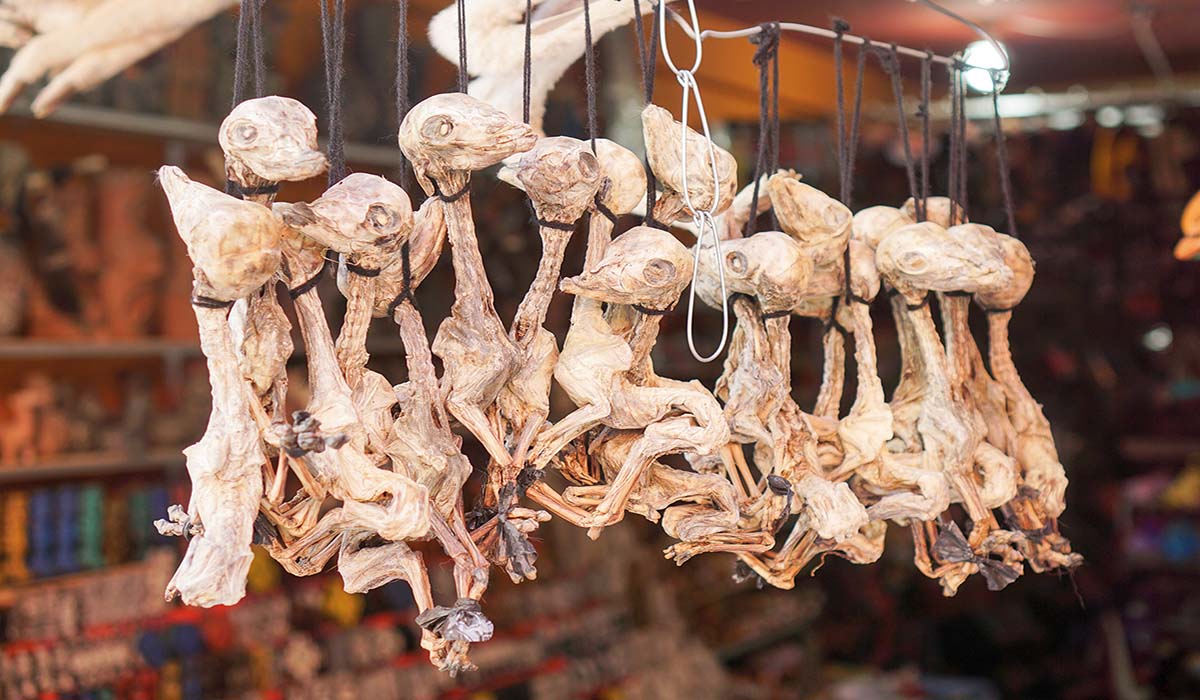
Chifleras and indigenous Life
We rode the teleferico back down to La Paz to look around an area known as the Mercado de Hechicería or Mercado de las Brujas (the Witches’ Market), whose colourful stores have become an essential stop on most tourist itineraries. Yet as Jorge explained, bruja (‘witch’ in Spanish) is a pejorative term and another example of the othering of indigenous Bolivians. ‘When the Spanish came, they called these women “witches”,’ he said. ‘But that is not what they are. They are chifleras.’ Loosely combining the roles of healer, therapist and mystic, chifleras play an important role for Aymara, Quechua and other indigenous people across the altiplano. They collect, sell and prepare items for use in traditional medicinal treatments, rituals and ceremonies, as well as offering guidance and advice. The othering of these women continues today in much of the travel writing about La Paz (including, to my shame, in guidebooks I’ve worked on in the past).
We stopped at one of the stores and Jorge introduced me to the owner, Lucia. Dressed in a blue-and-white checked dress, brown shawl and tiny, delicately placed bowler hat, she was in her early 20s and looked bored. To enter her minuscule store, which was barely bigger than a cupboard, I had to duck under a bunch of shrivelled llama foetuses hanging from the door frame. (Jorge later told me that only miscarried or stillborn foetuses were used in rituals and that live animals were never killed for this purpose.) Lucia’s mobile rang to the tune of Shakira’s ‘Hips Don’t Lie’ and she broke away from painting her fingernails purple to tap out a flurry of WhatsApp messages.
The low-ceilinged room was jam-packed. One wall was lined with aphrodisiacs with lurid photos of amorous couples and names such as ‘Come to me, come to me’, ‘Love Honey’ and ‘Erectol’. Perfumes promised to improve your mood or attract a partner, while plastic tubs contained potions for prostrate problems, hair loss, asthma and various other ailments. Plastic bags enclosed honeycombs, coca leaves, chia seeds and powder made from the root of the maca plant, which grows in the high Andes, as well as ‘extracts’ from creatures as diverse as snails and sharks. A menagerie of dead armadillos, birds, turtles, starfish and frogs, dehydrated and brittle, sat beneath the llama foetuses.
With a little encouragement, Lucia was drawn away from her phone and began to talk. ‘People ask me to prepare mesas blancas, offerings, to burn on the last Friday of the month to bring good luck,’ she said. Lucia then pointed at a crowd of stone figurines and talismans: ‘Those go on the mesas. Each one represents something different. The owls mean education; the entwined couple, love; the puma, safety; the condor, travel.’ She paused, before adding: ‘Now you should buy some condors, to bring good luck on your journey.’
Although the market is increasingly touristy, most of the shoppers were locals. I eavesdropped on a young, smartly dressed couple as they approached another chiflera, who was busy knitting a shawl. A llama foetus was purchased and shoved unceremoniously into a cloth bag, its dilated eyes peeking out of the top. Jorge explained that the foetuses are used in many rituals. ‘Sometimes they are buried under the foundations of buildings as an apology to Pachamama (Mother Earth) for digging into her and to bring prosperity,’ he said. ‘Sometimes they are burned for luck before a long journey.’
Jorge also spoke about the Kallawaya, members of an indigenous community based in a remote valley north of La Paz. For centuries, they’ve worked as healers, herbalists, doctors and religious figures across the Andes; some making it as far as Panama. The Kallawaya have an extensive knowledge of plants and herbs that dates back centuries; they are thought to have been the first to have used the bark of the cinchona tree, the source of quinine, to treat malaria. UNESCO has described the medical knowledge of the Kallawaya as ‘extraordinary’ and their 980-species ‘botanical pharmacopoeia … as one of the richest in the world.’

The past is not another country
On my final day in La Paz, I trekked towards Plaza Murillo, crossing constantly between sun and shade, perspiring one moment, shivering the next, trapped in a seemingly endless cycle of removing and adding layers of clothing. In the square, which is flanked by the presidential palace, parliament and cathedral, all was quiet, but Plaza Murillo has a bloody history.
In 1946, 79 years after the British ambassador was supposedly paraded naked around the square, President Gualberto Villaroel met an even worse fate. Inspired by reports of the death of Mussolini, protesters lynched Villareal, who combined reformist and fascist tendencies. Today, he’s known as el presidente colgado (the hanged president).
At the apex of the mustard-and-white parliament was a clock that Jorge had mentioned to me. As I approached it through a crowd of lustrabotas (shoeshiners), pigeon feeders and elderly couples, I noticed something strange and slightly unsettling on the clock face: the numbers were reversed and the hands ran anti-clockwise.
I later tracked down an interview with Bolivia’s then foreign minister, David Choquehuanca, who described it as a ‘clock of the south’. ‘[We’re] trying to recover our identity,’ he said. ‘In keeping with [this] … our clocks should turn to the left … Who said clocks always have to run the same way? Why do we always have to be obedient?’
Some claimed that the clock was a symbol of decolonisation, others saw it as a political stunt, yet it also reflected a fundamentally different conception of reality. To outsiders, Bolivia can sometimes feel like a place where Western conceptions of time and space don’t apply. Ancient beliefs and practices not only exist alongside modernity, but interact and even shape it. The past here is not another country.
For speakers of the Aymara language, this sense is even more pronounced: the past is in front of them, the future behind. In a 2006 paper, Rafael E Núñez and Eve Sweetser of the University of California wrote: ‘In Aymara, the basic word for “front” (nayra, “eye/front/sight”) is also a basic expression meaning “past”, and the basic word for “back” (qhipa, “back/behind”) is a basic expression for “future”.’
This isn’t merely a linguistic quirk, Núñez and Sweetser argue, but something that indicates an understanding of time and space profoundly different from every other studied culture. Aymara speakers know what happened in the past – they can see it in front of them. The future, however, isn’t known – it is behind them, hidden from view.

Shafik Meghji is a travel writer, journalist and author of more than 40 Rough Guides and DK Eyewitness Guides specialising in Latin America and Asia. This is an edited extract from his new book: Crossed Off the Map: Travels in Bolivia
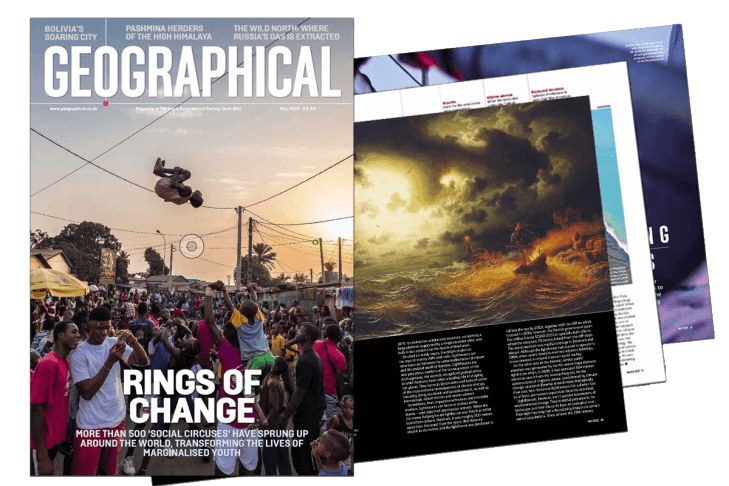
Subscribe to our monthly print magazine!
Subscribe to Geographical today for just £38 a year. Our monthly print magazine is packed full of cutting-edge stories and stunning photography, perfect for anyone fascinated by the world, its landscapes, people and cultures. From climate change and the environment, to scientific developments and global health, we cover a huge range of topics that span the globe. Plus, every issue includes book recommendations, infographics, maps and more!

